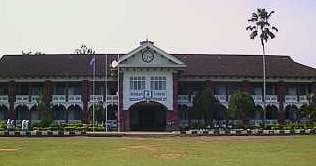Johor, formerly Johore, state of Malaysia, southernmost
state of peninsular Malaysia, bounded on the northwest by Melaka and Negeri
Sembilan states, and on the north by Pahang state. Singapore lies immediately
to the south across the narrow Johore Strait. Johor has a 400-km (250-mi)
coastline, extending from the Strait of Malacca to the South China Sea,
and an area of about 18,985 sq km (7330 sq mi). The state capital is Johor
Baharu.
Johor is generally low-lying and forest covered. However, there are
hilly uplands rising above 900 m (3000 ft) in the east-central region;
the highest point in the state is Gunang Ledang (Mount Ledang) (1276 m/4186
ft), near the border with Melaka state. Johor has many short rivers draining
from the central hills to the sea; the east coast has extensive swampy
areas.
Johor has a population (1991) of about 2.1 million, giving a population
density of 111 persons per sq km (286 per sq mi). Johor Baharu, lying on
the Johore Strait, has a population of 328,646; other large cities include
Segamat, Batu Pahat and Muar. The indigenous Malay population of the peninsula
makes up a little more than 50 percent of Johor's population; about one-third
of the population is of Chinese descent; about 6 percent is of Indian descent.
The Malay dialect spoken in Johor Baharu is the standard for Bahasa Malaysia,
the national language.
Partly cut off by swamps from the rest of the peninsula, Johor's economy
only began to develop strongly after 1919 when the railway was extended
southward, linking Johor and Singapore to the central tin- and rubber-producing
areas of the Malay Peninsula. After World War I (1914-1918), rubber plantations
were established, and tin, iron ore, and bauxite deposits were discovered.
Johor is one of the leading palm-oil producing states; coconuts and pineapples
flourish on the swampy coasts. Shallow harbors mean that the state's trade
is channeled through Singapore. Johor is linked to Singapore by a causeway
carrying a road and a railway over the Johore Strait; a second causeway
was expected to be completed by the mid-1990s. Although the port of Pasir
Gudang, on the Johore Strait, is being rapidly developed, Johor, economically,
is essentially part of Singapore's hinterland; economic relations with
Pahang state to the north are not developed. Ties to Singapore have helped
Johor's industrialization, especially through the growth of the electronics
industry.
Johor is one of the nine Malaysian states to have a hereditary ruler,
known as the sultan. Johor has 18 seats in the House of Representatives,
the lower house of the federal parliament; the state legislative assembly
has 36 seats. Johor was founded by Mahmud Shah, sultan of the kingdom of
Malacca (present-day Melaka state), after the fall of Malacca to the Portuguese
in 1511. Following a triangular struggle with the Dutch and the northwestern
Sumatran Sultanate of Aceh, for control of the Strait of Malacca, the state's
power declined in the 17th and 18th centuries. Johor's independence was,
however, recognized by the British when they founded Singapore in 1819.
Sultan Abu Bakar is considered the founder of modern Johor. He successfully
resisted British pressure for control during his rule (1862-1895), but
a permanent British adviser was finally imposed on Johor in 1914. In 1948
the state became part of the Federation of Malaya, the forerunner of modern
Malaysia.
Johor Baharu, city, western Malaysia, capital of Johor State, on Johore
Strait, near Singapore. It is the southernmost city of the Malay Peninsula,
connected with the island of Singapore by a rail and road causeway; the
road and rail systems of the peninsula begin here. Rubber, palm oil, pineapples,
and bauxite are produced in the surrounding area, and the city has fruit-canning
and oil-milling plants. Within the city are a large mosque, the sultan's
palace and gardens, and botanical and zoos. The suburbs have resort beaches.
Population (1991) 328,646.
Segamat, located on northernmost part of Johor is this site hometown.
|

